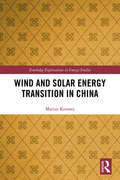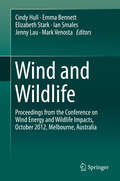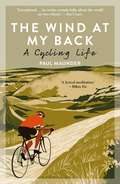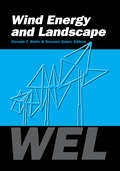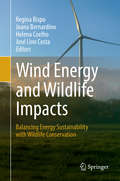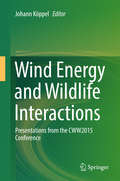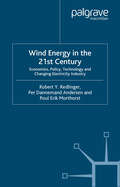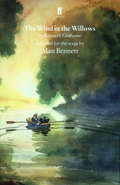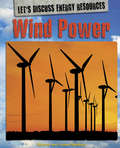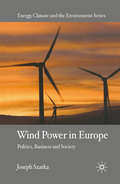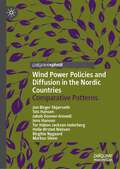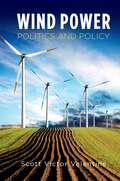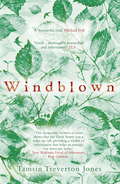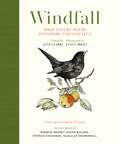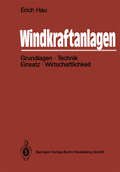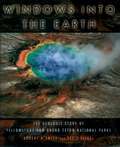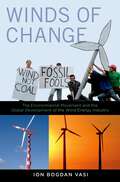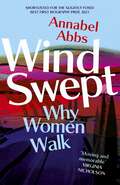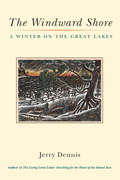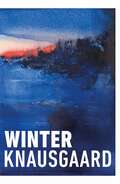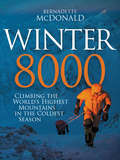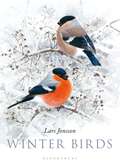- Table View
- List View
Wind and Solar Energy Transition in China (Routledge Explorations in Energy Studies)
by Marius KorsnesThis book explores the mobilisation of China’s wind and solar industries and examines the implications of this development to energy generation and distribution, innovation and governance. Unlike other publications that focus mainly on the formal policy landscape and statistics of industry development, this book delves deeper into the ways in which the wind and solar industries have evolved through negotiations made by the involved stakeholders, and how these industries play into larger Chinese development and policymaking interests. Overall, it sheds new light on the strategic development of China’s renewable energy industry, the flexible governance methods employed and the internal struggles which Chinese local, regional and central policymakers, and state-owned and private enterprises have faced. This book will be of great relevance to students and scholars of renewable energy technologies, energy policy and sustainability transitions, as well as policymakers with a specific interest in China.
Wind and Wildlife: Proceedings from the Conference on Wind Energy and Wildlife Impacts, October 2012, Melbourne, Australia
by Cindy Hull Emma Bennett Elizabeth Stark Ian Smales Jenny Lau Mark VenostaThis book gathers papers presented and discussions held at the Conference on Wind Energy and Wildlife Impacts in Melbourne, Australia on 9th October 2012. The purpose of the conference was to bring together researchers, industry, consultants, regulators and Non-Government Organizations to share the results of studies into wind farm and wildlife investigations in Australia and New Zealand. The aim was to further networking and communication between these groups. The conference discussed key issues and areas for future investigation, with the intention of developing consistencies in research and management. Like the Conference, the book showcases current research and management in the field of wind farms and wildlife in Australia and New Zealand; establishes consistencies in research and management; and highlights areas in need of further examination. The papers in these Proceedings are presented in two session topics. The first covers “Investigations and assessment of new wind farms” and the second, “Monitoring, mitigation and offsets.”The Proceedings then summarize the panel discussions held at the end of the conference. The themes include improving pre- and post-construction survey design; identifying key knowledge gaps and research priorities; uncertainties and errors in data sets and analysis; creating opportunities to share knowledge; and assessing cumulative impacts across multiple sites.
The Wind At My Back: A Cycling Life
by Mr Paul MaunderA lone cyclist, disappearing into a wild landscape – brave, free, engaged with the world. It's the kind of image that sells bikes, magazines, clothing; a romantic image that all cyclists aspire to. For cycling is an activity deeply and intimately involved with landscape. The bicycle allows us to explore, to engage with wild places, and return in time for dinner. It also allows us to investigate our surroundings closer to home. It is an activity which, for most of us, happens at a speed that allows a great deal of voyeurism. We peer into houses and shops, gardens and farmyards, fields and hedgerows. What we see may be familiar or alien, but for the creative mind it is always stimulating. Yet – unlike with walking or swimming – the connection between cycling and creativity has only been explored in fragments.On a bicycle, as one is exposed to sights – new or otherwise, through chance or purposeful searching – the repetitive physical actions of cycling work on the mind in a different way to those of walking. The shape of a long ride can become the shape of a novel; the atmosphere imbued by the weather, the hills, the physical exertion, can all influence a writer's tone. Our memories have a dialogue with the landscape; we remember rides through the landscape, and the landscape shapes our thinking. And for Paul Maunder – a writer all his adult life – cycling and creativity have always been interlinked. In The Wind on Your Back, Maunder takes a journey from the most dense centres of population to the wild places; starting from cycling in a major city, then moving through suburbia, the edgelands at the periphery of the city, then into the managed and pastoral farmland, and beyond to the sublime mountains.He explores the experience and history of cycling in these different types of place, and seeks to understand how cycling has played a role in his own creative life as well as that of other cyclist-artists, musicians, photographers, writers and painters. Played out against the backdrop of the British countryside, and drawing of elements of psychogeography and human geography, Maunder seeks to understand the way the outside world interacts with the creative mind, and the way our surroundings help to shape who we are.
Wind Energy and Landscape: Proceedings of the international workshop WEL, Genova, Italy, 26-27 June 1997
by Corrado F.Ratto and Giovanni SolariArising from an international workshop, these papers discuss aspects of wind turbines and the landscape. Topics: Harmonization of wind turbines with landscape; Visual and audio impact of wind turbines; Interference with telecommunication; Impact of wind turbines on birds; Real experiences in different countries; Offshore wind farms; Wind turbines in coastal and mountainous areas; Wind turbines, thunderstorms and lightning; Economic and social impact of wind turbines; Insurance policies regarding wind turbines; Greater public acceptance of wind turbines.
Wind Energy and Landscape: Proceedings of the international workshop WEL, Genova, Italy, 26-27 June 1997
by C. F. Ratto G. SolariArising from an international workshop, these papers discuss aspects of wind turbines and the landscape. Topics: Harmonization of wind turbines with landscape; Visual and audio impact of wind turbines; Interference with telecommunication; Impact of wind turbines on birds; Real experiences in different countries; Offshore wind farms; Wind turbines in coastal and mountainous areas; Wind turbines, thunderstorms and lightning; Economic and social impact of wind turbines; Insurance policies regarding wind turbines; Greater public acceptance of wind turbines.
Wind Energy and Wildlife Impacts: Balancing Energy Sustainability with Wildlife Conservation
by Regina Bispo Joana Bernardino Helena Coelho José Lino CostaThis book provides a state-of-art overview of the significant advances in understanding the impacts of wind energy on wildlife. However, many challenges remain regarding planning and policy, assessment of direct and indirect effects on wildlife, methodological approaches, technology development, and mitigation strategies and their effectiveness. The book comprises a selection of the best contributions presented at the 4th Conference on Wind energy and Wildlife impacts, held in Estoril, Portugal, 2017. The contents promote the international cooperation among researchers, developers, regulators and stakeholders that have contributed to building knowledge on this topic.
Wind Energy and Wildlife Interactions: Presentations from the CWW2015 Conference
by Johann KöppelThis book presents a selection of new insights in understanding and mitigating impacts on wildlife and their habitats. Topics such as, species behaviour and responses; collision risk and fatality estimation; landscape features and gradients, are considered. Other chapters in the book cover the results of current research on mitigation; compensation; effectiveness of measures; monitoring and long-term effects; planning and siting. Examples are given of current research on shutdown on demand and curtailment algorithms. By identifying what we have learned so far, and which predominate uncertainties and gaps remain for future research, this book contributes to the most up to date knowledge on research and management options. This book includes presentations from the Conference on Wind Energy and Wildlife impacts (CWW15), March 2015, hosted by the Berlin Institute of Technology, which offered a platform to national and international participants to showcase the current state of knowledge in wind energy’s wildlife implications.
Wind Energy in the 21st Century: Economics, Policy, Technology and the Changing Electricity Industry
by R. Redlinger P. Andersen P. MorthorstWind energy is the great success story of modern renewable energy. Since the industry's rebirth following the energy crisis of the 1970s, thousands of wind energy projects have been installed around the world. The technology today is competitive with traditional fossil-fuelled electricity generation. Wind Energy in the 21st Century explores the current economic, financial, technical, environmental, competitive, and policy considerations facing the wind energy industry. With discussions of the latest electricity industry trends including deregulation, green markets, and tradable renewable credits, this book is a must-read for energy policymakers, researchers, and energy industry professionals.
The Wind in the Willows
by Alan Bennett'Believe me, my young friend, there is absolutely nothing half so much worth doing as simply messing about in boats. In them or out of them, it doesn't matter. Whether you get away or you don't, whether you arrive at your destination or whether you never get anywhere at all, you're always busy.'Ever since the publication of Kenneth Grahame's novel in 1908, the characters of Ratty, Mole, Toad and Badger have delighted generations of readers. Now Alan Bennett has written an adaptation for the stage, a version which is both true to the original and yet carries that distinctive Bennett hallmark.Alan Bennett introduces this edition, writing about the history of the project and the staging of the production.'Bennett is even able to inject the odd sly joke for the adult without bewildering the tots... the result is a delightful evening, a treat for anyone.' The Times
Wind Power: Wind Power Library Ebook (Let's Discuss Energy Resources #1)
by Richard Spilsbury Louise SpilsburyWith supplies of non-renewable energy sources running low and the threat of global warming and climate change, there is an urgent need to look at other types of energy resources and how well they can meet our power needs. While new technologies are being developed, each energy resource comes at a cost. This series looks at each energy resource, the technology and cost of how it is used to meet power needs and how it impacts the environment and humans. Each book explains how that power is generated and where it is used, and then, using specific Let's Discuss panels, explores the various advantages and disadvantages that concern it's use as an alternative fuel source. Case studies examine specific usage examples where that source has either worked or not worked so that the reader can weigh up the pros and cons for the use of each source against the alternatives.
Wind Power in Europe: Politics, Business and Society (Energy, Climate and the Environment)
by J. SzarkaAt a time when humanity is challenged by fossil fuel depletion and climate change, this book explains the development of wind power as a major energy growth sector, stressing the interactions between political, economic and social dimensions as the key to understanding public acceptability and uptake.
Wind Power Policies and Diffusion in the Nordic Countries: Comparative Patterns
by Jon Birger Skjærseth Teis Hansen Jakob Donner-Amnell Jens Hanson Helle Ørsted Nielsen Birgitte Nygaard Markus Steen Tor Håkon InderbergThis book focuses specifically on policy mixes and wind power diffusion in four Nordic countries – Denmark, Finland, Norway and Sweden. Although these Nordic welfare states have much in common, they have adopted different wind power policies and experienced dissimilar diffusion trajectories. Understanding these patterns across the Nordic countries is the central puzzle that this book investigates. Empirically, this book provides a first-of-its-kind comparative study of wind power policies in the Nordic countries. Analytically, the authors contribute to the transition policy mix literature, which remains largely insensitive to political feasibility. This book will be of interest to researchers and students as well as private and public decision makers looking for tools to enable the energy transition.
Wind Power Politics and Policy
by Scott Victor ValentineThe wind power development policy community faces a conundrum. On the one hand, as the most commercially viable form of utility-scale renewable energy, the wind power industry has experienced in excess of ten-fold growth in total installed capacity over the past decade. On the other hand, installed wind power capacity still accounts for less than 2% of global electricity-generation capacity, despite the prevalence of studies indicating that, in certain situations, wind power can be a cheaper form of electricity than most fossil fuel alternatives. Accordingly, the most puzzling aspect of wind power development policy can be summed up in the following manner: given the global imperative to facilitate an expedient transition away from CO2-intensive energy technologies and the commercial viability of wind power, what is stopping the wind power industry from capturing higher market shares around the world? In Wind Power Politics and Policy, Scott Valentine examines this question from two angles. First, it presents an analysis of social, technical, economic and political (STEP) barriers which research shows tends to stymie wind power development. Case studies which examine phlegmatic wind power development in Japan, Taiwan, Australia and Canada are presented in order to demonstrate to the reader how these barriers manifest themselves in practice. Second, the book presents an analysis of STEP catalysts which have been linked to successful growth of wind power capacity in select nations. Four more case studies that examine the successful development of wind power in Denmark, Germany, the USA and China are put forth as practical examples of how supportive factors conflate to produce conditions that are conducive to growth of wind power markets. By examining its impediments and catalysts, the book will provide policymakers with insight into the types of factors that must be effectively managed in order to maximize wind power development.
Windblown: Landscape, Legacy and Loss - The Great Storm of 1987
by Tamsin Treverton JonesTrees are part of the British psyche. We care if just one tree is cut down unnecessarily. So what happens when 15 million are blown down in one night? Part travelogue, part memoir, part celebration of nature's ability to heal itself, Windblown is as rich in character and story-telling as the rings of an ancient oak.'Windblown is a marvellously original mixture of reportage and memoir, holding a memorable event in recent history up to the light and making sense of it' Bel Mooney'A wonderful read' Michael Fish'Vivid ... thoroughly researched and informative' TLS'This eloquently written account shows that the Great Storm was a wake-up call, providing a wealth of information that helps us manage our treescape today.' Tony Kirkham, Head of the Kew Gardens Arboretum
Windfall: Irish Nature Poems to Inspire and Connect
by Jane ClarkeWhat does Ireland's nature poetry say about us as a people? How does it speak to us of our past, our inheritance, the values to which we aspire? What clues lie within its language that connect us to our deeper selves and our place within our communities and environments?As varied as our plants, animals and habitats, Windfall: Irish Nature Poems to Inspire and Connect presents a portrait of an ever-changing vista. Jane Carkill's captivating original illustrations of Ireland's rich and diverse natural world add to the sense of enchantment and wonder.Each poem pays attention to nature while also reflecting on the loves and losses of our everyday lives. Award-winning poet Jane Clarke's selection includes some of our best-known poets, from Seamus Heaney, Eavan Boland, Michael Longley, Paula Meehan, Nuala Ní Dhomhnail, Eilean Ní Chuilleanáin and Paul Muldoon.There are poems here to make us laugh and cry, to help us celebrate and grieve; poems to put words on what can seem inexpressible as we connect to the other living beings with which we share this island.
Windkraftanlagen: Grundlagen, Technik, Einsatz, Wirtschaftlichkeit
by Erich HauIn diesem Handbuch wird die Technologie moderner Windkraftanlagen systematisch und umfassend dargestellt. Ausgehend von den historischen Wurzeln der Windkraftnutzung führt der Autor über die technisch-physikalischen Grundlagen, den konstruktiven Aufbau, die Einsatzkonzeptionen und die Umweltverträglichkeit bis hin zu Wirtschaftlichkeitsuntersuchungen der Stromerzeugung mit Windenergie. Erstmalig wird eine fundierte Analyse der Herstellkosten moderner Windkraftanlagen gegeben und - darauf aufbauend - die Hauptfrage untersucht, unter welchen Bedingungen man mit dieser besonders umweltfreundlichen Energie wirtschaftlich Strom erzeugen kann. Hierbei werden Investitions- und Betriebskosten genau so berücksichtigt wie die Amortisation dieser modernen Technologie und deren Bedeutung im gesamtwirtschaftlichen Rahmen einer hochentwickelten Industriegesellschaft.
Windows into the Earth: The Geologic Story of Yellowstone and Grand Teton National Parks
by Robert B. Smith Lee J. SiegelMillions of years ago, the North American continent was dragged over the world's largest continental hotspot, a huge column of hot and molten rock rising from the Earth's interior that traced a 50-mile wide, 500-mile-long path northeastward across Idaho. Generating cataclysmic volcanic eruptions and large earthquakes, the hotspot helped lift the Yellowstone Plateau to more than 7,000 feet and pushed the northern Rockies to new heights, forming unusually large glaciers to carve the landscape. It also created the jewel of the U.S. national park system: Yellowstone. Meanwhile, forces stretching apart the western U.S. created the mountainous glory of Grand Teton National Park. These two parks, with their majestic mountains, dazzling geysers, and picturesque hot springs, are windows into the Earth's interior, revealing the violent power of the dynamic processes within. Smith and Siegel offer expert guidance through this awe-inspiring terrain, bringing to life the grandeur of these geologic phenomena as they reveal the forces that have shaped--and continue to shape--the greater Yellowstone-Teton region. Over seventy illustrations--including fifty-two in full color--illuminate the breathtaking beauty of the landscape, while two final chapters provide driving tours of the parks to help visitors enjoy and understand the regions wonders. Fascinating and informative, this book affords us a striking new perspective on Earth's creative forces.
Windows into the Earth: The Geologic Story of Yellowstone and Grand Teton National Parks
by Robert B. Smith Lee J. SiegelMillions of years ago, the North American continent was dragged over the world's largest continental hotspot, a huge column of hot and molten rock rising from the Earth's interior that traced a 50-mile wide, 500-mile-long path northeastward across Idaho. Generating cataclysmic volcanic eruptions and large earthquakes, the hotspot helped lift the Yellowstone Plateau to more than 7,000 feet and pushed the northern Rockies to new heights, forming unusually large glaciers to carve the landscape. It also created the jewel of the U.S. national park system: Yellowstone. Meanwhile, forces stretching apart the western U.S. created the mountainous glory of Grand Teton National Park. These two parks, with their majestic mountains, dazzling geysers, and picturesque hot springs, are windows into the Earth's interior, revealing the violent power of the dynamic processes within. Smith and Siegel offer expert guidance through this awe-inspiring terrain, bringing to life the grandeur of these geologic phenomena as they reveal the forces that have shaped--and continue to shape--the greater Yellowstone-Teton region. Over seventy illustrations--including fifty-two in full color--illuminate the breathtaking beauty of the landscape, while two final chapters provide driving tours of the parks to help visitors enjoy and understand the regions wonders. Fascinating and informative, this book affords us a striking new perspective on Earth's creative forces.
Winds of Change: The Environmental Movement and the Global Development of the Wind Energy Industry
by Ion Bogdan VasiIn recent decades the global wind energy industry has undergone explosive growth, and there is still vast potential for wind to supply more of the world's energy. Though not only is wind power far from reaching its potential, its rise has been uneven and irregular. What factors influence the development of the wind energy industry, and why has it developed successfully in some places but not in others? In Winds of Change, Ion Bogdan Vasi argues that the development of wind energy is dependent not only on improvements in technology and economic forces, but also in large part on the efforts of the environmental movement. Vasi defines and analyses three pathways through which the environmental movement has contributed to industry growth: it has influenced the adoption and implementation of renewable energy policies, created consumer demand for clean energy, and changed the institutional logics of the energy sector. Vasi uses quantitative analysis to present the big picture of global wind power development, and qualitative research to understand why certain countries are world leaders in wind energy while others are relatively underdeveloped. Through interviews with renewable energy professionals and campaigners, he shows that environmental groups and activists participated actively in energy policymaking, pressured various organizations to purchase wind power, and formed new companies that specialized in wind-farm development. He also demonstrates that environmentalists contributed to wind turbine manufacturing by becoming entrepreneurs, innovators, and advocates. Winds of Change sheds much new light on how wind energy is adopted and why, and demonstrates how activists and social movements can contribute to the creation of new industries.
Windswept: walking in the footsteps of remarkable women
by Annabel Abbs'A triumph ... I felt as though I were being lifted, carried up to peaks.' - Charlotte Peacock, author of. Into the Mountain: A Life of Nan Shepherd 'I couldn't put it down. Quite extraordinary... written in such a free flowing, readable style. I'm in awe.' - Maggie Humm, author of Talland HouseThe story of extraordinary women who lost their way - their sense of self, their identity, their freedom - and found it again through walking in the wild. A feminist exploration of the power of walking in nature, following in the footsteps of Gwen John, Georgia O'Keeffe, Frieda Lawrence, Clara Vyvyan, Simone de Beauvoir, Daphne Du Maurier and Nan Shepherd. For centuries, the wilds have been male territory, while women sat safely confined at home. But not all women did as they were told, despite the dangers; history is littered with women for whom rural walking became inspiration, consolation and liberation. In this powerful and deeply inspiring book, Annabel Abbs uncovers women who refused to conform, who recognised a biological, emotional and artistic need for wilderness, water and desert - and who took the courageous step of walking unpeopled and often forbidding landscapes. Part wild-walk, part memoir, Windswept follows an exhilarating journey from Abbs' isolated car-less childhood to her walking the remote paths trodden by extraordinary women including Georgia O'Keeffe in the empty plains of Texas and New Mexico, Nan Shepherd in the mountains of Scotland, Gwen John following the Garonne, Simone de Beauvoir in the mountains and forests of France and Daphne du Maurier following the River Rhone. A single question pulses through their walks: How does a woman change once she becomes windswept?
Windswept: Life, Nature and Deep Time in the Scottish Highlands
by null Annie Worsley‘Windswept is a wonderful work, prose painted in bold, bright strokes like a Scottish Colourist's canvas’ ROBERT MACFARLANE ‘An instant classic of British nature-writing’ SUNDAY TELEGRAPH A few years ago, Annie Worsley traded a busy life in academia to take on a small-holding or croft on the west coast of Scotland. It is a land ruled by great elemental forces – light, wind and water – that hold sway over how land forms, where the sea sits and what grows. Windswept explores what it means to live in this rugged, awe-inspiring place of unquenchable spirit and wild weather. Walk with Annie as she lays quartz stones in the river to reflect the moonlight and attract salmon, as she watches otters play tag across the beach, as she is awoken by the feral bellowing of stags. Travel back in time to the epic story of how Scotland’s valleys were carved by glaciers, rivers scythed paths through mountains, how the earliest people found a way of life in the Highlands – and how she then found a home there millennia later. With stunning imagery and lyrical prose, Windswept evokes a place where nature reigns supreme and humans must learn to adapt. It is her paean to a beloved place, one richer with colour, sound and life than perhaps anywhere else in the UK.
The Windward Shore: A Winter on the Great Lakes
by Jerry Dennis"Our country is lucky to have Jerry Dennis. A conservationist with the soul of a poet whose beat is Wild Michigan, Dennis is a kindred spirit of Aldo Leopold and Sigurd Olson. The Windward Shore---his newest effort---is a beautifully written and elegiac memoir of outdoor discovery. Highly recommended!" ---Douglas Brinkley, author of The Wilderness Warrior: Theodore Roosevelt and the Crusade for America "Come for a journey; stay for an awakening. Jerry Dennis loves the Great Lakes, the swell of every wave, the curve of every rock. He wants you to love them too before our collective trashing of them wipes out all traces of their original character. Through his eyes, you will treasure the hidden secrets that reveal themselves only to those who linger and long. Elegant and sad at the same time, The Windward Shore is a love song for the Great Lakes and a gentle call to action to save them." ---Maude Barlow, author of Blue Covenant: The Global Water Crisis and the Coming Battle for the Right to Water "In prose as clear as the lines in a Dürer etching, Jerry Dennis maps his home ground, which ranges outward from the back door of his farmhouse to encompass the region of vast inland seas at the heart of our continent. Along the way, inspired by the company of water in all its guises---ice, snow, frost, clouds, rain, shore-lapping waves---he meditates on the ancient questions about mind and matter, time and attention, wildness and wonder. As in the best American nature writing---a tradition that Dennis knows well---here the place and the explorer come together in brilliant conversation." ---Scott Russell Sanders, author of A Conservationist Manifesto If you have been enchanted by Jerry Dennis’s earlier work on sailing the Great Lakes, canoeing, angling, and the natural wonders of water and sky—or you have not yet been lucky enough to enjoy his engaging prose—you will want to immerse yourself in his powerful and insightful new book on winter in Great Lakes country. Grounded by a knee injury, Dennis learns to live at a slower pace while staying in houses ranging from a log cabin on Lake Superior’s Keweenaw Peninsula to a $20 million mansion on the northern shore of Lake Michigan. While walking on beaches and exploring nearby woods and villages, he muses on the nature of time, weather, waves, agates, books, words for snow and ice, our complex relationship with nature, and much more. From the introduction: “I wanted to present a true picture of a complex region, part of my continuing project to learn at least one place on earth reasonably well, and trusted that it would appear gradually and accumulatively—and not as a conventional portrait, but as a mosaic that included the sounds and scents and textures of the place and some of the plants, animals, and its inhabitants. Bolstered by the notion that a book is a journey that author and reader walk together, I would search for promising trails and follow them as far as my reconstructed knee would allow.”
Winter: (Seasons Quartet 2) (Seasons Quartet #2)
by Karl Ove Knausgaard Lars Lerin Ingvild BurkeyThe second volume in his autobiographical quartet based on the seasons, Winter is an achingly beautiful collection of daily meditations and letters addressed directly to Knaugsaard's unborn daughterIt is strange that you exist, but you don’t know anything about what the world looks like. It’s strange that there is a first time to see the sky, a first time to see the sun, a first time to feel the air against one’s skin. It’s strange that there is a first time to see a face, a tree, a lamp, pyjamas, a shoe. In my life that almost never happens anymore. But soon it will. In just a few months, I will see you for the first time. In Winter, we rejoin the great Karl Ove Knausgaard as the birth of his daughter draws near. In preparation for her arrival, he takes stock of the world, seeing it anew. While new life is on the horizon, the earth is also in hibernation, waiting for the warmer weather to return. In his inimitably sensitive style, he writes about everything from the moon, winter boots and messiness, to owls and birthdays. Taking nothing for granted, he fills these everyday familiar objects and ideas with new meaning. Startling, compassionate, and exquisitely beautiful, Knausgaard's writing is like nothing else. Somehow, he shows the world as it really is, at once mundane and sublime.
Winter 8000: Climbing the world's highest mountains in the coldest season (Legends And Lore Ser.)
by Bernadette McDonald‘He appeared, without a word, in the tent’s entrance, covered in ice. He looked like anyone would after spending over twenty-four hours in a hurricane at over 8,000 metres. In winter. In the Karakoram. He was so exhausted he couldn’t speak.’Of all the games mountaineers play on the world’s high mountains, the hardest – and cruellest – is climbing the fourteen peaks over 8,000 metres in the bitter cold of winter. Ferocious winds that can pick you up and throw you down, freezing temperatures that burn your lungs and numb your bones, weeks of psychological torment in dark isolation: these are adventures for those with an iron will and a ruthless determination.For the first time, award-winning author Bernadette McDonald tells the story of how Poland’s ice warriors made winter their own, perfecting what they dubbed ‘the art of suffering’ as they fought their way to the summit of Everest in the winter of 1980 – the first 8,000-metre peak they climbed this way but by no means their last. She reveals what it was that inspired the Poles to take up this brutal game, how increasing numbers of climbers from other nations were inspired to enter the arena, and how competition intensified as each remaining peak finally submitted to leave just one awaiting a winter ascent, the meanest of them all: K2.Winter 8000 is the story of true adventure at its most demanding.
Winter Birds
by Lars JonssonIn this stunning book, Lars Jonsson celebrates and explores the beauty of the birds that surround him during the Swedish winter months. Inspired by the desolate, wintry landscapes, the dazzling light and the stark contract of colours he observes against the snow, Jonsson has created an unparalleled collection of art.Jonsson illustrates each bird in his classic style, and his text provides information on their behaviour and insights into how to identify them as he shares personal observations as both an artist and ornithologist. This unique combination offers an intimate and compelling opportunity to better understand the method behind one of the world's preeminent bird artists.
